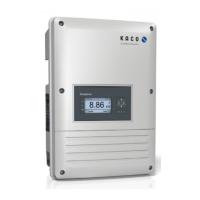
Do you have a question about the Kaco blueplanet 3.0 TL3 M2 WM OD IIG0 and is the answer not in the manual?
| Model | blueplanet 3.0 TL3 M2 WM OD IIG0 |
|---|---|
| Rated Power | 3000 W |
| AC Nominal Power | 3000 W |
| Max. Apparent AC Power | 3000 VA |
| AC Grid Frequency | 50 Hz / 60 Hz |
| Max. DC Voltage | 1000 V |
| MPP Voltage Range | 200 V - 800 V |
| Number of MPP Trackers | 2 |
| Protection Class | IP65 |
| Weight | 17 kg |
| Cooling | Natural convection |
| AC Power Output | 3000 W |
| AC Output Voltage | 230 V |
| AC Output Frequency | 50/60 Hz |
| Operating Temperature Range | -25°C to +60°C |
| AC Voltage Range | 180 V - 280 V |
| Max. AC Current | 13 A |
| Input Voltage Range | 200 V - 800 V |
Details the warranty conditions for the product.
Clarifies terminology used for the product designation.
Explains the status of brand and product names as trademarks.
Explains the document's purpose and related literature.
Lists links to additional technical documents and resources.
Explains symbols used, safety warnings, and instruction types.
Details DANGER, WARNING, and CAUTION symbols and their risks.
Describes how to find product identification data on the name plate.
Instructs to read and not remove warning stickers affixed to the device.
Outlines the qualifications required for personnel performing tasks.
Warns about lethal voltages present even after switching off the device.
Defines the intended use of the device and country-specific requirements.
Lists integrated monitoring and protection functions within the device.
Explains how the device converts DC to AC and feeds it into the grid.
Provides a visual diagram of the device with key components labeled.
Describes available interfaces for communication and remote monitoring.
Presents DC input and AC output electrical specifications in a table.
Lists general data like efficiency, self-consumption, protection class, and interfaces.
Provides environmental data like installation height, temperature, and protection rating.
Lists items included in the delivery and checks for equipment.
Warns about handling precautions and provides packaging details.
Details DANGER and CAUTION for selecting a safe and suitable installation site.
Provides CAUTION for lifting and instructions for safely unpacking the unit.
Explains how to securely fasten the mounting bracket to the wall.
Guides on lifting, mounting, and securing the device, including heat dissipation notes.
Describes how to uncover and survey the DC connection area.
Provides NOTE on selecting conductor cross-section and safety values.
Guides on configuring the AC connection plug and connecting wires.
Introduces connecting the PV generator and checking for ground faults.
Explains how to earth the device with a second ground connection if required.
Introduces connecting interfaces and warns about electrostatic discharge.
Warns about lethal voltages and states only qualified professionals can commission.
Mentions attaching safety labels and the self-test function requirements.
Explains the initial start-up configuration assistant and settings.
Describes the meaning of LEDs on the control panel for different operating states.
Explains the start screen, graphical display, and control buttons.
Guides on opening menus, selecting options, and changing settings.
Illustrates the main menu structure displayed on the LCD.
Provides a detailed menu map with actions and meanings.
Explains using the integrated web server to monitor operating state and yield.
Explains how to update the device software using the USB interface.
Guides on enabling Modbus TCP and accessing the device via Modbus.
Explains the use of reactive power for voltage stabilization in supply networks.
Explains active power regulation for grid stability and limiting feed-in power.
Explains Dynamic grid support (Fault Ride Through).
Introduces other grid-supporting functions related to active power.
Explains the importance of islanding detection for grid stability and safety.
Guides on inspecting the product and cables for damage and noting status.
Warns about risks of fatal injury due to contact voltages during maintenance.
Warns about severe injuries or death from touching live components.
Provides instructions for cleaning the device housing.
Warns about lethal voltages and outlines steps for safely shutting down the device.
Introduces faults and the procedure for rectifying them.
Lists possible status and fault messages displayed by the device.
Warns about lethal voltages and outlines steps for safely switching off the device.
Warns about destruction of DC plug connectors due to arcing.
Guides on safely disconnecting AC and DC connections.
Warns about dangerous voltages and guides on unmounting the device.
Provides notes on proper storage to prevent condensation and device damage.
Warns about environmental risks of incorrect disposal.
Notes that warranty length is based on national conditions.
Confirms compliance with EU directives and standards for safety and EMC.
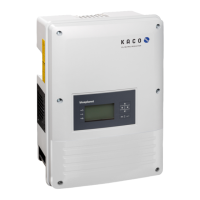
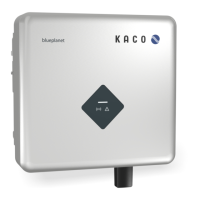
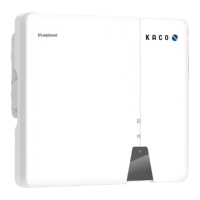
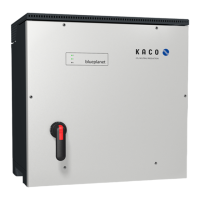


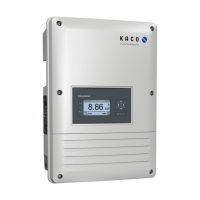
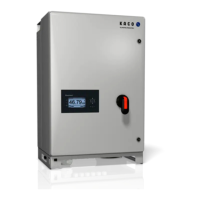
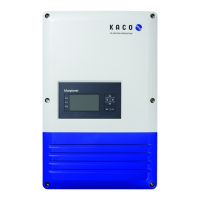
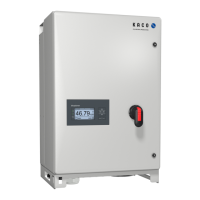
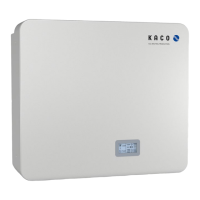
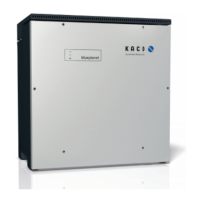
